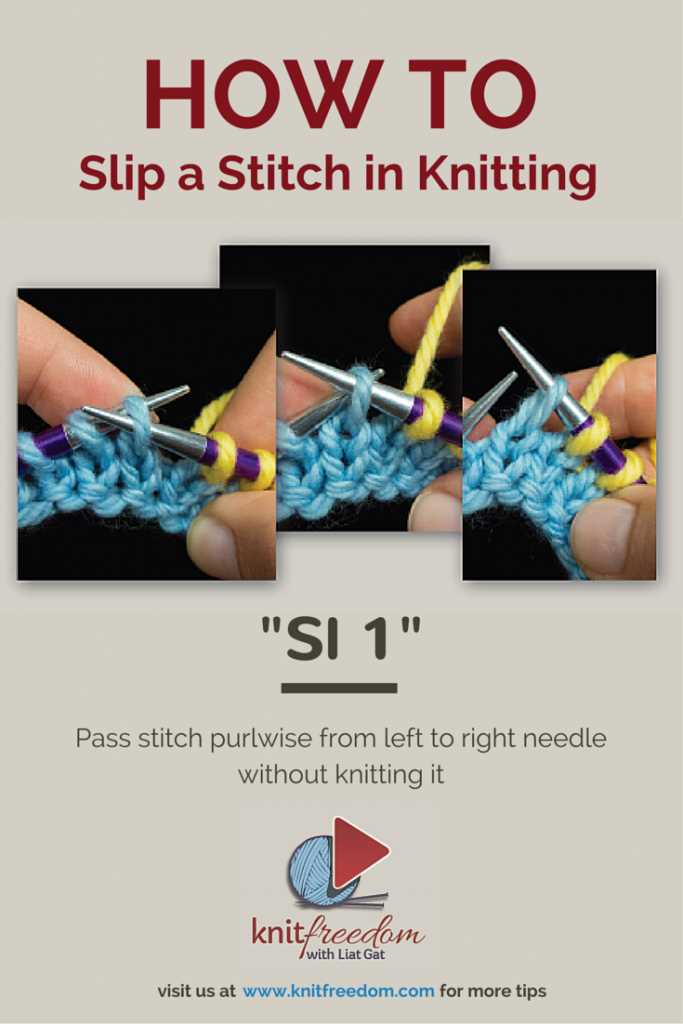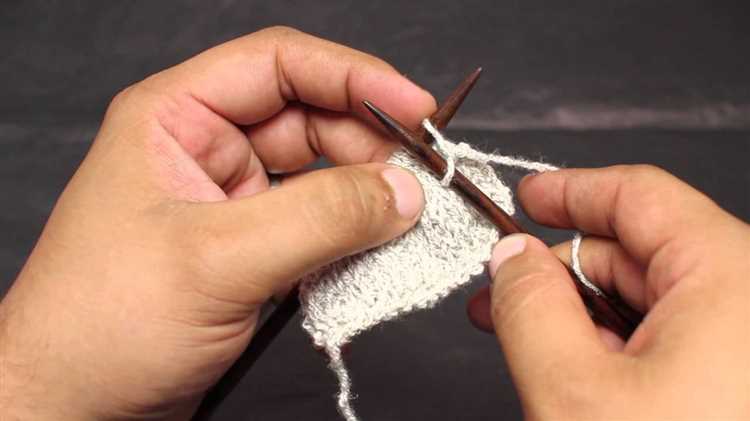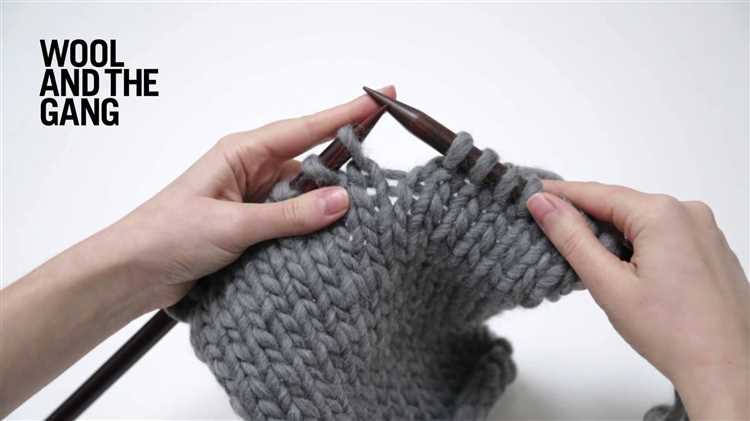Knitting is a versatile and creative craft that allows you to create beautiful clothing, accessories, and home decor. Whether you’re a beginner or an experienced knitter, learning how to add a stitch can open up a whole new world of possibilities in your knitting projects. Adding stitches can be used to create decorative patterns, increase the width of your project, or even shape your garment.
Adding a stitch in knitting is a simple technique that involves creating a new loop on your knitting needle. This can be done in various ways, depending on the desired effect and the stitch pattern you’re following. In this step-by-step guide, we will explore some common methods for adding a stitch and provide clear instructions to help you master this skill.
Before you start adding stitches, make sure you have a basic understanding of knitting terminology and techniques. It’s important to have a firm grasp on how to hold your needles, make basic stitches like knit and purl, and read a simple knitting pattern. With these foundational skills in place, you’ll be ready to tackle the process of adding a stitch with confidence.
The Basics of Knitting
Knitting is a craft that involves creating fabric by interlocking yarn with knitting needles. It is a versatile hobby that allows you to create a wide variety of items, such as clothing, accessories, and home decor. Whether you’re a beginner or an experienced knitter, it’s always helpful to review the basics before starting a new project.
Materials Needed
- Knitting Needles: Choose a pair of needles that are appropriate for your yarn weight. The size of the needles determines the size of the stitches.
- Yarn: There are countless types of yarn available, ranging in weight, texture, and color. Choose a yarn that is suitable for your project.
- Scissors: Used for cutting the yarn.
- Tapestry Needle: Used for weaving in loose ends and sewing pieces together.
Basic Knitting Stitches
The two main knitting stitches are the knit stitch and the purl stitch. These stitches create different textures and patterns in your knitted fabric.
- Knit Stitch: Insert the right needle into the front of the stitch on the left needle, then wrap the yarn around the right needle in a counterclockwise motion. Pull the right needle through the stitch, creating a new stitch on the right needle.
- Purl Stitch: Insert the right needle into the front of the stitch on the left needle, then wrap the yarn around the right needle in a clockwise motion. Pull the right needle through the stitch, creating a new stitch on the right needle.
Knitting Terms
There are several common terms used in knitting that are important to know:
- Cast On: The process of creating the first stitches on the needle.
- Bind Off: The process of finishing a piece by creating a secure edge.
- Row: A horizontal line of stitches.
- Gauge: The number of stitches and rows per inch of knitted fabric. It is important to match the gauge specified in your pattern to ensure proper sizing.
- Pattern: A set of instructions that guide you through creating a specific design.
Knitting Techniques
In addition to the basic stitches, there are various techniques that can be used to create different effects in your knitting:
- Cables: Crossing stitches to create a twisted effect.
- Lace: Creating patterned holes and spaces in the fabric.
- Colorwork: Working with multiple colors in a single row or round.
- Increasing: Adding stitches to your work.
- Decreasing: Removing stitches from your work.
Finishing Techniques
Once you have completed your knitting project, there are a few finishing techniques to consider:
- Weaving in Ends: Using a tapestry needle to hide loose yarn ends in the fabric.
- Blocking: Wetting or steaming your finished piece to shape and set the stitches.
- Seaming: Sewing pieces together to create a finished item.
Learning the basics of knitting is the first step towards becoming an accomplished knitter. With practice and patience, you can create beautiful and functional items with your knitting skills. So grab some needles and yarn, and start exploring the world of knitting!
Materials needed for knitting
- Yarn: Choose a yarn of the appropriate weight and texture for your project. Yarn comes in various materials such as wool, acrylic, cotton, and blends.
- Knitting Needles: Select knitting needles that are suitable for your yarn and project. Needles come in different sizes and lengths, and can be made of various materials like metal, wood, or plastic.
- Scissors: Have a pair of sharp scissors on hand for cutting the yarn.
- Tape Measure: A tape measure will help you measure your gauge and ensure that your project turns out the right size.
- Stitch Markers: Use stitch markers to mark specific stitches or sections in your knitting to help keep track of your progress.
- Yarn Needle: A yarn needle with a large eye is essential for weaving in loose ends and finishing your project.
- Row Counter: A row counter is a handy tool to keep track of the number of rows you have knitted.
- Pattern: Your chosen knitting pattern will guide you through the stitches and techniques required to complete your project.
These are the basic materials you will need to get started with knitting. Depending on the project, you may also require additional materials such as buttons, zippers, or other embellishments.
Understanding different types of stitches
- Knit stitch (k): This is the most basic stitch in knitting. It creates a smooth, flat surface on one side of the fabric, while forming a series of interlocking loops on the other side.
- Purl stitch (p): The purl stitch is the reverse of the knit stitch. It creates a bumpy texture on one side of the fabric and a smooth surface on the other side. When combined with knit stitches, it can create ribbing and various patterns.
- Stockinette stitch: This stitch pattern is created by alternating rows of knit and purl stitches. It results in a smooth, flat surface on one side (the knit side) and a bumpy texture on the other side (the purl side).
- Garter stitch: This simple stitch pattern is created by knitting every row. It produces a fabric with ridges or bumps on both sides. Garter stitch is often used for borders, edges, and scarves.
- Seed stitch: The seed stitch pattern is achieved by alternating knit and purl stitches within a row. It creates a textured fabric with small clusters of bumps or “seeds” on both sides.
- Rib stitch: Ribbing is a pattern created by alternating knit and purl stitches in a specific sequence. It is commonly used for cuffs, collars, and hems to provide stretch and elasticity to the fabric.
- Cable stitch: Cables are created by crossing a group of stitches over each other, resulting in a twisted or braided appearance. This stitch pattern adds visual interest and texture to knitted fabric.
- Lace stitch: Lace patterns are made by incorporating yarn overs and decreasing stitches to create decorative openings or “holes” in the fabric. Lace stitches are often used for delicate shawls, scarves, and other airy garments.
These are just a few examples of the many different types of stitches that can be used in knitting. By learning and practicing these stitches, you can create a wide range of textures, patterns, and designs in your knitted projects.
Step-by-step guide on how to add a stitch
-
Start by holding the working needle with the stitches in your left hand and the empty needle in your right hand.
-
Insert the right needle into the stitch from front to back, just like you would for a regular knit stitch.
-
Wrap the yarn around the right needle from back to front, making sure the yarn is positioned correctly between the needles.
-
Use the right needle to pull the loop of yarn through the stitch, creating a new stitch on the right needle.
-
Transfer the new stitch from the right needle back to the left needle.
-
Repeat steps 2-5 until you have added the desired number of stitches.
-
Continue knitting the next row as usual with the added stitches.
Tips and tricks for adding stitches while knitting
Adding stitches while knitting can be a helpful technique when trying to increase the size of your project or create decorative patterns. Here are some tips and tricks to help you add stitches seamlessly.
- Make a yarn over: One of the easiest ways to add a stitch is by creating a yarn over. To do this, simply bring the yarn to the front of your work, then wrap it over the right-hand needle and continue with the next stitch.
- Knit into the front and back of a stitch: Another way to increase stitches is by knitting into the front and back of a stitch. After knitting the stitch as usual, instead of taking it off the left-hand needle, knit into the back loop of the same stitch. This creates a new stitch.
- Use a make 1 (M1) increase: The make 1 increase method is commonly used for adding stitches. There are different variations of the M1 increase, such as M1L (make 1 left) and M1R (make 1 right), which create slightly different results. These increases involve picking up the bar between stitches and knitting into it.
- Work a knit front and back (KFB) increase: Similar to knitting into the front and back of a stitch, the KFB increase is another method for adding stitches. After knitting the stitch as usual, rather than removing it from the left-hand needle, knit into the back loop of the same stitch. This creates an additional stitch.
- Utilize the invisible increase: The invisible or lifted increase is a method that results in a nearly invisible increase. Insert the right-hand needle into the strand in between the last and next stitch from the front, then knit into the back loop of this strand.
Remember to maintain an even tension throughout your knitting to ensure that the added stitches blend seamlessly with the rest of your project. Practice these techniques on a swatch or scrap yarn before incorporating them into your actual knitting.
Adding stitches while knitting opens up a world of possibilities for creating unique designs and increasing the size of your project. With these tips and tricks, you’ll be able to confidently add stitches and take your knitting to the next level.
Common mistakes to avoid when adding stitches
Adding stitches to knitting can be a tricky process, and it’s easy to make mistakes. Here are some common mistakes to avoid:
- Not counting carefully: When adding stitches, it’s important to count how many stitches you have before and after the addition. This will help ensure that you have added the correct number of stitches and that your work remains symmetrical.
- Adding stitches in the wrong place: When adding stitches, they should be added in the appropriate location in the row or round. Adding them in the wrong place can throw off the pattern and result in an uneven or distorted fabric.
- Twisting the stitches: When adding stitches, it’s important to insert the needle correctly to avoid twisting the stitches. Twisted stitches can be difficult to work with and can create problems in the overall fabric.
- Not securing the new stitches: When adding stitches, it’s important to ensure that the new stitches are properly secured by pulling the working yarn tight. This helps to prevent gaps or loose stitches in the fabric.
- Adding too many stitches: It’s important to carefully follow the pattern instructions when adding stitches to avoid adding too many. Adding too many stitches can result in an incorrect stitch count and an uneven or misshapen fabric.
Avoiding these common mistakes will help ensure that your knitting project turns out beautifully and that your added stitches blend seamlessly with the rest of your work.
Advanced techniques for adding stitches
The following advanced techniques can be used to add stitches while knitting:
- M1 (Make One) – Increase: This technique involves creating a new stitch by picking up the horizontal bar between two stitches with the left needle, and then knitting into the back of this stitch to prevent a hole from forming.
- KFB (Knit Front and Back) – Increase: This technique involves knitting into the front and back of the same stitch, effectively creating two stitches from one. This is commonly used for making increases in a stitch pattern.
- Yarn Over – Increase: Yarn overs are used to create eyelets and decorative holes in lace knitting patterns. To yarn over, simply bring the yarn to the front of the work, then over the needle to the back, creating a loop that will count as a stitch on the next row.
It is important to note that when adding stitches, it is essential to consider the stitch pattern and the desired effect. Each technique has its own characteristics and can have different effects on the appearance and function of the knitted fabric.
By mastering these advanced techniques for adding stitches, knitters can expand their repertoire and tackle more complex projects with confidence.
FAQ:
What materials do I need to add a stitch while knitting?
To add a stitch while knitting, you will need yarn, knitting needles, and a knitting pattern.
Can you explain the step-by-step process of adding a stitch while knitting?
Sure! To add a stitch while knitting, first, locate the stitch to be increased. Then, insert the right needle into the stitch as if to knit. Next, bring the yarn in front of the work and wrap it around the right needle from back to front. Finally, pull the new loop through the stitch and place it onto the left needle. You have now successfully added a stitch while knitting!
Is it difficult to add a stitch while knitting?
Adding a stitch while knitting may seem challenging at first, but with a little practice, it becomes easier. Just make sure to follow the step-by-step instructions and take your time. You’ll quickly get the hang of it!
Why would I need to add a stitch while knitting?
There are several reasons why you may need to add a stitch while knitting. For example, if you are creating a pattern that requires increasing the number of stitches, or if you accidentally dropped a stitch and need to pick it up again. Adding a stitch allows you to adjust the size and shape of your knitted piece.


